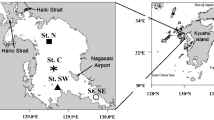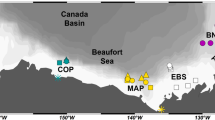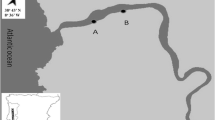Abstract
Meiobenthos samples were collected from Gullmar Fjord, on the Swedish west coast, for just over 2 yr (December 1978–February 1981, inclusive), spanning a short period of severe hypoxia. Previously published analysis indicated no meiofaunal response at the major taxon level. Nematode samples were further analysed to the genus level. Data were analysed with both univariate and multivariate statistics. Although there was no immediate response to the hypoxic period, changes in assemblage structure at both genus and family level during the subsequent year may have been caused by it: diversity was reduced, multivariate assemblage structure was altered, and within-site variability was considerably increased. These changes may have resulted directly from the influence of hypoxia on reproductive success and juvenile survival and/or indirectly as a consequence of the complete disappearance of the macrobenthos (due to the hypoxia) which would alter macrobenthos-meiobenthos interactions. A year after the hypoxia there was no evidence that the nematode assemblage structure was returning to its pre-hypoxia state. This suggests that in physically undisturbed, deep sites, such as the Gullmar Fjord basin, recovery of nematode assemblages after environmental disturbance may be a lengthy process.
Similar content being viewed by others
Literature cited
Clarke, K. R. (1990). Comparisons of dominance curves. J. exp. mar. Biol. Ecol. 138: 143–157
Coull, B. C. (1969). Hydrographic control of meiobenthos in Bermuda. Limnol. Oceanogr. 14: 953–957
Elmgren, R. (1973). Methods of sampling sublittoral soft bottom meiofauna. Oikos (Suppl.) 15: 112–120
Fenchel, T. M., Riedel, R. J. (1970). The sulfide system: a new biotic community underneath the oxidized layer of marine sand bottoms. Mar. Biol. 7: 255–268
Heip, C., Warwick, R. M., Carr, M. R., Herman, P. M. J., Huys, R., Smol, N., Van Holsbeke, K. (1988). Analysis of community attributes of the benthic meiofauna of Frierfjord/Langesundfjord. Mar. Ecol. Prog. Ser. 46: 171–180
Josefson, A. B. (1981). Effects of oxygen deficiency and long-term changes in sediment properties on the macrobenthic infauna in the Gullmar Fjord basin. [In Swedish]. Kristineberg Marine Biological Station, Fiskebäacksil, Sweden (Mimeo; Report to the Swedish Environmental Protection Board)
Josefson, A. B., Widbom, B. (1988). Differential response of benthic macrofauna and meiofauna to hypoxia in the Gullmar Fjord basin. Mar. Biol. 100: 31–40
Lambshead P. J. D., Platt, H. M., Shaw, K. M. (1983). The detection of differences among assemblages of marine benthic species based on an assessment of dominance and diversity. J. nat. Hist. 17: 859–874
McIntyre, A. D., Warwick, R. M. (1984). Meiofauna techniques. In: Holme, N. A., McIntyre, A. D. (eds.) Methods for the study of marine benthos. 2nd ed. Blackwell, Oxford, p. 217–244
Murrell, M. C., Fleeger, J. W. (1989). Meiofauna abundance on the Gulf of Mexico continental shelf affected by hypoxia. Contin. Shelf Res. 9: 1049–1062
Olafsson, E., Moore, C. G., Bett, B. J. (1990). The impact ofMelinna palmata Grube, a tube-building polychaete, on meiofaunal community structure in a soft-bottom subtidal habitat. Estuar. cstl Shelf Sci. 31: 883–893
Ott, J. A. (1972). Determination of fauna boundaries of nematodes in an intertidal sand flat. Int. Revue ges. Hydrobiol. 57: 645–663
Ott, J. A., Novak, R. (1989). Living at an interface: meiofauna at the oxygen/sulfide boundary of marine sediments. In: Ryland, J. S., Tyler, P. A. (eds.) Reproduction, genetics and distribution of marine organisms. Olsen & Olsen, Fredensborg, p. 415–422. (Proc. 23rd Eur. mar. Biol. Symp.)
Ott, J. A., Schiemer, F. (1973). Respiration and anaerobiosis of free living nematodes from marine and limnic sediments. Neth. J. Sea Res. 7: 233–243
Palmer, M. A. (1988). Dispersal of marine meiofauna: a review and conceptual model explaining passive transport and active emergence with implications for recruitment. Mar. Ecol. Prog. Ser. 48: 81–91
Theede, H. (1973). Comparative studies of the influence of oxygen deficiency and hydrogen sulphide on marine bottom invertebrates. Neth. J. Sea Res. 7: 244–252
Theede, H., Ponat, A., Hiroki, K., Schlieper, C. (1969). Studies on the resistance of marine bottom invertebrates to oxygen-deficiency and hydrogen sulphide. Mar. Biol. 2: 325–337
Warwick, R. M., Clarke, K. R., Gee, J. M. (1990a). The effect of disturbance by soldier crabsMictyris platycheles H. Milne Edwards on meiobenthic community structure. J. exp. mar. Biol. Ecol. 135: 19–33
Warwick, R. M., Clarke, K. R., Suharsono (1990b). A statistical analysis of coral community responses to the 1982–1983 El Niño in the Thousand Islands, Indonesia. Coral Reefs 8: 171–179
Warwick, R. M., Gee, J. M. (1984). Community structure of estuarine meiobenthos. Mar. Ecol. Prog. Ser. 18: 97–111
Warwick, R. M., Gee, J. M., Berge, J. A., Ambrose Jr, W. G. (1986). Effects of the feeding activity of the polychaeteStreblosoma bairdi (Malmgren) on meiofaunal abundance and community structure. Sarsia 71: 11–16
Warwick, R. M., Platt, H. M., Clarke, K. R., Agard, J., Gobin, J. (1990c). Analysis of macrobenthic and meiobenthic community structure in relation to pollution and disturbance in Hamilton Harbour, Bermuda, J. exp. mar. Biol. Ecol. 138: 119–142
Widbom, B., Elmgren, R. (1988). Response of benthic meiofauna to nutrient enrichment of experimental marine ecosystems. Mar. Ecol. Prog. Ser. 42: 257–268
Wieser, W., Kanwisher, J. (1961). Ecological and physiological studies on marine nematodes from a salt marsh near Woods Hole, Massachusetts. Limnol. Oceanogr. 6: 262–270
Author information
Authors and Affiliations
Additional information
Communicated by J. Mauchline, Oban
Rights and permissions
About this article
Cite this article
Austen, M.C., Wibdom, B. Changes in and slow recovery of a meiobenthic nematode assemblage following a hypoxic period in the Gullmar Fjord basin, Sweden. Mar. Biol. 111, 139–145 (1991). https://doi.org/10.1007/BF01986355
Accepted:
Issue Date:
DOI: https://doi.org/10.1007/BF01986355




